DOCUMENTATION ON FUNCTION WITH WALKLINE VERSUS SHOE WITHOUT WAKLINE INTEGRATED
(Result of exposure studies with Walkline - more details in menu 1.1)
Introduction: 53% of employees report that they have one or more foot problems. This is confirmed in a large test that have been conducted of 15,000 employees in the Norwegian and Scandinavian industry. Companies: Nexans, Scancell, ISS, Norwegian Army, oil industry, and more. Today we have identified 18 factors in shoe that can: trigger, maintain, or worsen one or more foot problems. In close cooperation with Bata industrials europe has we developed a shoes that have integrated a biomechanical support system (BMS) that we call Walkline. The result: increased movement in the foot joints, increasing comfort experience. Decreased foot, leg, and knee problems.
Goals:We have identified four clear problem areas that must be answered.
1. Are shoes a factor for development of non specific foot problems?
Answer is definitely YES, and extensive documentation of this is presented in a separate report.
2. Provides measurable change in footwear biomechanics result in the foot?
We have been able to identify 18 area with shoe that can give negative biomechanical influences in the foot. Extensive documentation of this is presented in a separate report.
3. What experience have the end-user with using of Walkline?
Comfort experience 94% reported that they were very pleased with the shoe. Foot problems were reduced by 60%. Extensive documentation of this is presented in a separate report.
4. Provides Walkline side effects?
Some candidates (2 person) reported little pain in the groin area that lasted one to two days. Of 85 candidates who tested WL were that not reported other conditions, or problems.
Methodology: All candidates have similar kind of work profileof in each company taking part in the research. Pedometric analysis gives an average walk rate of 5400 steps per day. All candidates have been assessed in relation to our requirements for inclusion and exclusion criteria to take part in the study.
Our goal is an objective dynamic study with the main focus on the end user experience. To achieve these goals, we have chosen different relevant methods. I note the prevalence of foot problems in the shoes who the candidate is used before test starts,and after they have used shoe with Walkline in a periode for 4 months. Bata Industrials Europe (Bata) designs and manufactures shoes for the practical part of the study.
We performed:
1. Dynamic analysis of the foot in the shoe over time by Datapedographical analysis.
2. Ergonomic test of shoes they have used before the test.
3. Conducted interviews of candidates before and after the test.
4. All candidates answered a self-report form before and after the study.
5. All candidates who tested walkline underwent a test of the movement in the foot.
6. Force-plate test of shoes to measure pressure distribution in the outsole when we are walking with and without Walkline intergrated in the shoe.
7. High speed video analysis
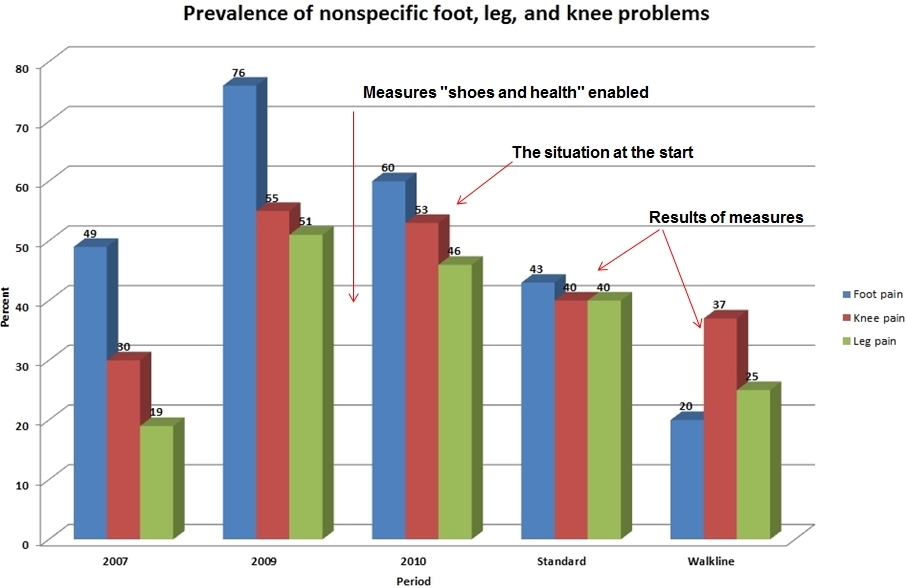
Fig.1 In 2007 using all employees own shoes. In 2009 they were required to wear safety shoes, the choice on shoe the company made was bad. The shoes that were cheap but inadequate ergonomic features. The result was that the prevalence of forproblemene got out of control. In 2010 changed all employees to shoes with good ergonomics, and the prevalence of foot problems came under control. From the end of 2010, research with Walkline initiated. The research went over a period of 6 months. The results are startling. Report of the research is available. Why? The answer is that when we eliminate or reduce the effect of the negetive factors in shoes (we have identified 18 negative factors in shoes), when the cause is gone, this will result in the reduction of foot problems.
| Deviation of the longitenduinal axis in the shoe versus the foot | Concavity of the forefoot arei in the shoe. | ||||||||||||||||||||||||||||||||||||||||
|
|
||||||||||||||||||||||||||||||||||||||||
|
Fig 2. The survey was conducted with self-report form. Sum score is the total number of summarized issues registered on the brand of shoe. Divergence is the number of millimeters axis deviation longitenduinal axis. Low scores are best.
|
Fig 3. The survey was conducted by measuring the concavity of the shoe front portion, corresponding transverse arch. The goals reflect millimeters concavity. The degree of concavity of the shoe gives the wrong position in the transverse arch. We call this shoes related Pes plano transversus (forefoot flat foot).
|
| N=270 | N=187 | ||||||||||||||||||||||||||||||||
|
|
||||||||||||||||||||||||||||||||
| Fig 4 | Fig 5 | ||||||||||||||||||||||||||||||||
| N=530 | N=600 | ||||||||||||||||||||||||||||||||
|
|
||||||||||||||||||||||||||||||||
| Fig 6. | Fig 7. | ||||||||||||||||||||||||||||||||
|
* Fig 6. The shoe have 25 millimeters axis deviation longitenduinal axis, and 7 millimeters concavity in forefoot area. Fig 7. The shoe have 40 millimeters axis deviation longitenduinal axis, and 9 millimeters concavity in forefoot area. |
|||||||||||||||||||||||||||||||||

| Datapedographical analysis of shoe without Walkline | Datapedographical analysis of shoe with Walkline integrated | ||
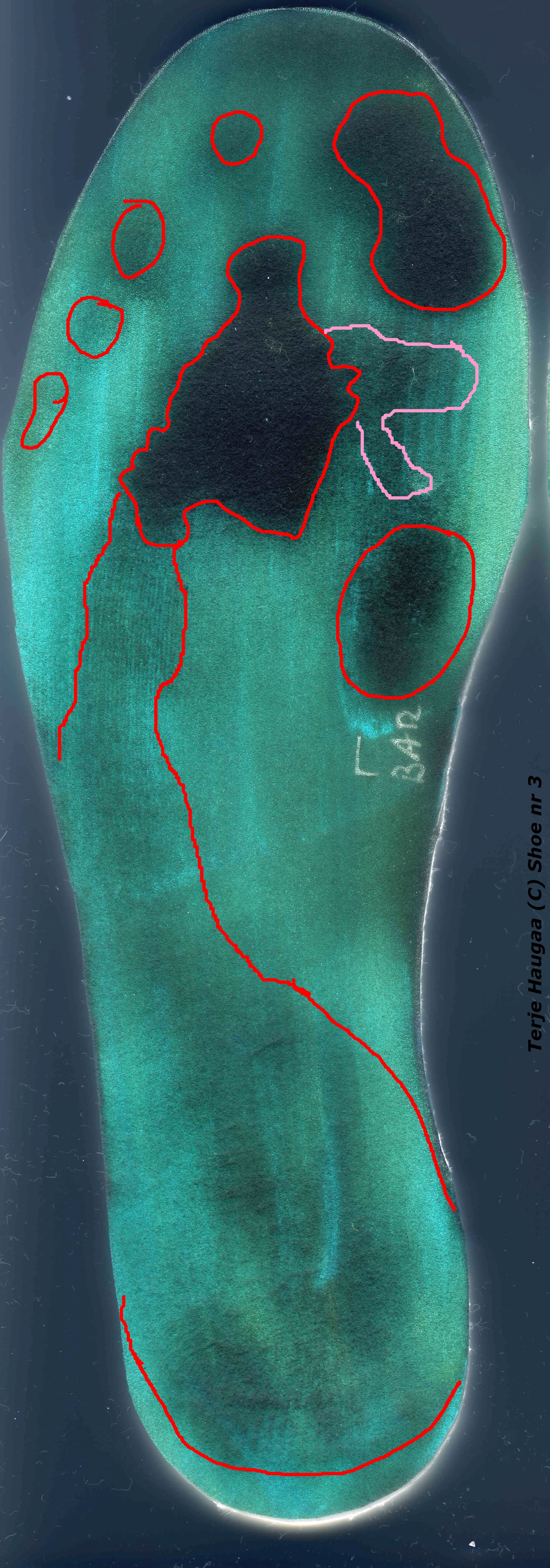 |
|
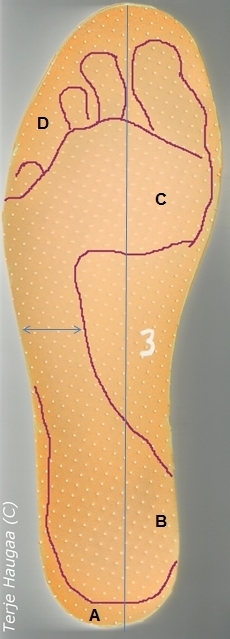 |
 |
|
Fig 9. Here we have used the material for quick datapedographical analysis. Analysis is after 3000 meters. |
Fig 10.Here we have used the material for overtime datapedographical analysis. Analysis is after 3 months. |
Fig 11 and 12. Is from different shoes with integrated Walkline. Fig 11 is the same as Fig 9 (without Walkline). All analyzes are of the same person in different shoes. |
|
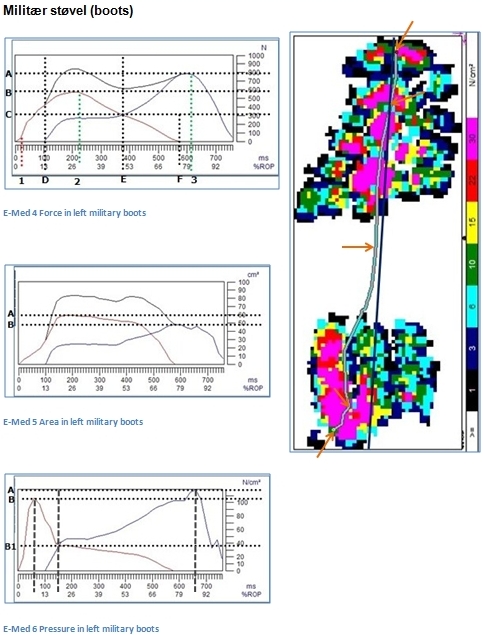 |
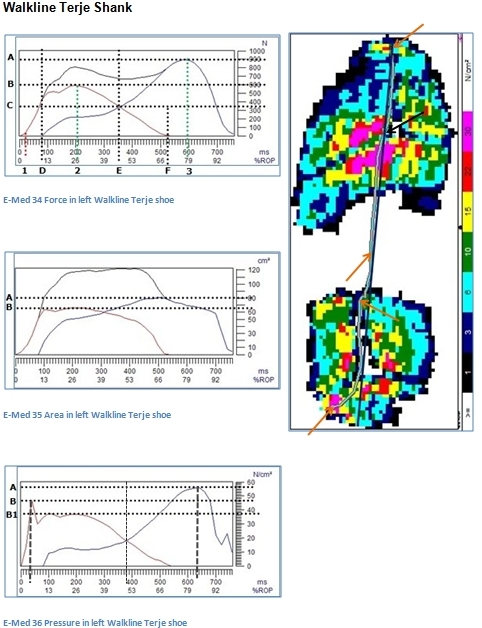 |
| Fig.13 Shoe without Walkline. | Fig.14 Shoe with Walkline integratet |
Fig.13 and14 have been tested of the same person. The shoe are structurally very similar. Density and hardness in outsole is like. |
|
| Shoe with Walkline (test group) N=87 | Shoe without Walkline (control group) N=87 | ||||||||||||||||||||||||||||||||||||||||
|
|
||||||||||||||||||||||||||||||||||||||||
| Fig 15. | Fig 16. |
Fig 15 and 16. Is the same shoe from the same produser, but fig 15 have integrated WL and fig 16 have not. Candidate from the same factory and have same work condition.
|
Test shoe (EN 20345) |
NN1 (fig 7) |
*Standard |
*Walkline |
|
Measurement period from start |
6 mounth |
6 mounth |
6 mounth |
|
Increase in movement from start |
4 mm |
6 mm |
9 mm |
|
Fig 17.NN1 The shoe have 40 millimeters axis deviation longitenduinal axis, and 9 millimeters concavity in forefoot area.* Standard and * Walkline is same shoe with and without BMS. Details in menu 1.1. |
|||
Tørke - varme
Sokketest fuktighet - varme (ytterlighetene)